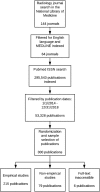An analysis of key indicators of reproducibility in radiology
- PMID: 32394098
- PMCID: PMC7214585
- DOI: 10.1186/s13244-020-00870-x
An analysis of key indicators of reproducibility in radiology
Abstract
Background: Given the central role of radiology in patient care, it is important that radiological research is grounded in reproducible science. It is unclear whether there is a lack of reproducibility or transparency in radiologic research.
Purpose: To analyze published radiology literature for the presence or lack of key indicators of reproducibility.
Methods: This cross-sectional retrospective study was performed by conducting a search of the National Library of Medicine (NLM) for publications contained within journals in the field of radiology. Our inclusion criteria were being MEDLINE indexed, written in English, and published from January 1, 2014, to December 31, 2018. We randomly sampled 300 publications for this study. A pilot-tested Google form was used to record information from the publications regarding indicators of reproducibility. Following peer-review, we extracted data from an additional 200 publications in an attempt to reproduce our initial results. The additional 200 publications were selected from the list of initially randomized publications.
Results: Our initial search returned 295,543 records, from which 300 were randomly selected for analysis. Of these 300 records, 294 met inclusion criteria and 6 did not. Among the empirical publications, 5.6% (11/195, [3.0-8.3]) contained a data availability statement, 0.51% (1/195) provided clear documented raw data, 12.0% (23/191, [8.4-15.7]) provided a materials availability statement, 0% provided analysis scripts, 4.1% (8/195, [1.9-6.3]) provided a pre-registration statement, 2.1% (4/195, [0.4-3.7]) provided a protocol statement, and 3.6% (7/195, [1.5-5.7]) were pre-registered. The validation study of the 5 key indicators of reproducibility-availability of data, materials, protocols, analysis scripts, and pre-registration-resulted in 2 indicators (availability of protocols and analysis scripts) being reproduced, as they fell within the 95% confidence intervals for the proportions from the original sample. However, materials' availability and pre-registration proportions from the validation sample were lower than what was found in the original sample.
Conclusion: Our findings demonstrate key indicators of reproducibility are missing in the field of radiology. Thus, the ability to reproduce studies contained in radiology publications may be problematic and may have potential clinical implications.
Keywords: Meta-analysis; Radiology; Reproducibility of results; Transparency.
Conflict of interest statement
The authors declare that they have no competing interests.
Similar articles
-
Evaluating Reproducibility and Transparency in Emergency Medicine Publications.West J Emerg Med. 2021 Jul 14;22(4):963-971. doi: 10.5811/westjem.2021.3.50078. West J Emerg Med. 2021. PMID: 35353995 Free PMC article.
-
An Evaluation of Nephrology Literature for Transparency and Reproducibility Indicators: Cross-Sectional Review.Kidney Int Rep. 2019 Nov 13;5(2):173-181. doi: 10.1016/j.ekir.2019.11.001. eCollection 2020 Feb. Kidney Int Rep. 2019. PMID: 32043031 Free PMC article.
-
An assessment of transparency and reproducibility-related research practices in otolaryngology.Laryngoscope. 2020 Aug;130(8):1894-1901. doi: 10.1002/lary.28322. Epub 2019 Oct 8. Laryngoscope. 2020. PMID: 31593300 Review.
-
Analysis of practices to promote reproducibility and transparency in anaesthesiology research.Br J Anaesth. 2020 Nov;125(5):835-842. doi: 10.1016/j.bja.2020.03.035. Epub 2020 Jun 28. Br J Anaesth. 2020. PMID: 32611528 Review.
-
A review of reproducible and transparent research practices in urology publications from 2014 to2018.BMC Urol. 2022 Jul 11;22(1):102. doi: 10.1186/s12894-022-01059-8. BMC Urol. 2022. PMID: 35820886 Free PMC article. Review.
Cited by
-
Sample size calculation for data reliability and diagnostic performance: a go-to review.Eur Radiol Exp. 2024 Jul 5;8(1):79. doi: 10.1186/s41747-024-00474-w. Eur Radiol Exp. 2024. PMID: 38965128 Free PMC article. Review.
-
Generalizability of prostate MRI deep learning: does one size fit all data?Eur Radiol. 2023 Nov;33(11):7461-7462. doi: 10.1007/s00330-023-09886-5. Epub 2023 Aug 1. Eur Radiol. 2023. PMID: 37526670 No abstract available.
-
Accountability in EUS: Is it possible?Endosc Ultrasound. 2022 Aug 17;11(4):249-251. doi: 10.4103/EUS-D-22-00088. eCollection 2022 Jul-Aug. Endosc Ultrasound. 2022. PMID: 37520662 Free PMC article. No abstract available.
-
Systematic review of research design and reporting of imaging studies applying convolutional neural networks for radiological cancer diagnosis.Eur Radiol. 2021 Oct;31(10):7969-7983. doi: 10.1007/s00330-021-07881-2. Epub 2021 Apr 16. Eur Radiol. 2021. PMID: 33860829 Free PMC article.
-
Reproducibility of Deep Learning Algorithms Developed for Medical Imaging Analysis: A Systematic Review.J Digit Imaging. 2023 Oct;36(5):2306-2312. doi: 10.1007/s10278-023-00870-5. Epub 2023 Jul 5. J Digit Imaging. 2023. PMID: 37407841 Free PMC article.
References
-
- Jackson WL (2014) Imaging utilization trends and reimbursement. Diagn Imaging.
-
- Pitcher RD. The role of radiology in global health. In: Mollura DJ, Culp MP, Lungren MP, editors. Radiology in Global Health: Strategies, Implementation, and Applications. Cham: Springer International Publishing; 2019. pp. 157–174.
-
- WHO | Medical imaging. February 2017. https://www.who.int/diagnostic_imaging/en/. Accessed June 27, 2019.
LinkOut - more resources
Full Text Sources
Miscellaneous


